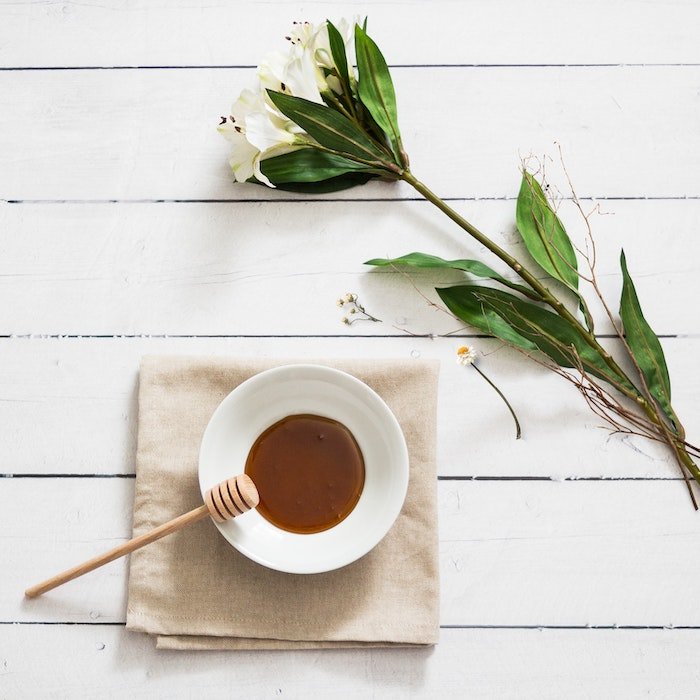The best thing about food is that it’s delicious and inspiring! Look at all these mouth-watering colors and textures and tell me this isn’t food art.
This is even more true when you combine the alchemy of cooking with the subtle art of curves, serifs, and loops. Of course, I’m talking about food typography, a still-life photography we will explore in this article.
I’ve always been a big fan of 3D lettering—text made from flowers, chocolate, or wire. But I’m genuinely hopeless at calligraphy. My writing is almost illegible, and I can’t draw a straight line to save my life.
That doesn’t mean people like me should miss out on all the fun, right? So, let’s make our messages and texts out of something simple and accessible, like food! It’s time to step up our food photography game. We’ll go over the basics and then go through a tutorial.
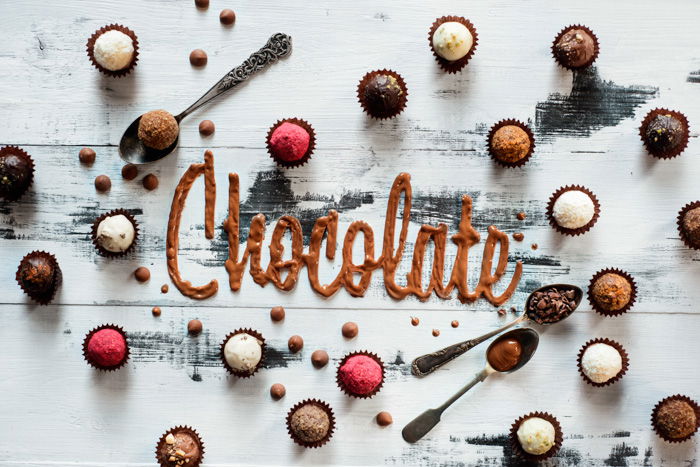
How to Create Food Typography Still Life
First, some questions must be asked in advance to review ideas, problems, and solutions. Still-life photography, in general, requires time spent preparing for the photoshoot. This is especially true for food typography.
And it’s not just because arranging a hundred M&Ms into a coherent sentence requires a lot of patience. You also need to know all the details. Here are some questions to consider:
- Exactly what are you going to write?
- How large are your letters going to be?
- Exactly how many M&M’s (food items) do you need?
- How do you want to compose the image?
- What kind of background are you going to use?
Plan your shooting. Make a sketch. And decide which tools and materials for food styling you will use.
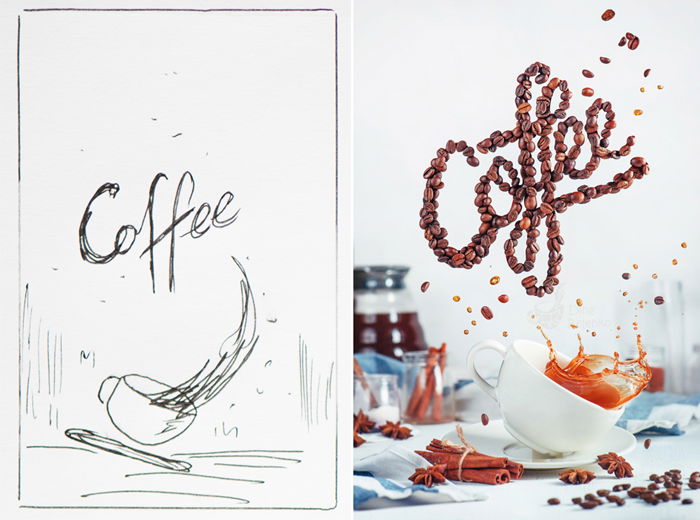
You need to answer three main questions:
- What sentence do you want to create?
- How are you going to form letters?
- What materials do you want to use?
We’ll take a closer look at each one in the next section.
1. What to Write for Food Typography
Coming up with words for your first food typography experiment is entirely up to you. But here are a couple of ideas to get your imagination kickstarted.
Of course, it’s better to start small and not to write the first page of Leo Tolstoy’s War and Peace. Short words let you crop tighter and shoot closer to food. The viewer can see the details and the delicious texture of your sweet or savory drawing materials.
Your first choice can be just the name of the food you’re using. Writing “radish” with slices of radish or salad made from its ingredients. You can also go for a brief exclamation like “sweet,” “cool,” or “yum.”
If you want a longer sentence, offer someone another cup of tea or one more waffle. Wish someone “good morning” or “bon appétit.” Tell your kids not to play with their food (while playing with food yourself, yes).
Phrases like “I’m going to the gym tomorrow,” written with all kinds of sweets, also look lovely!
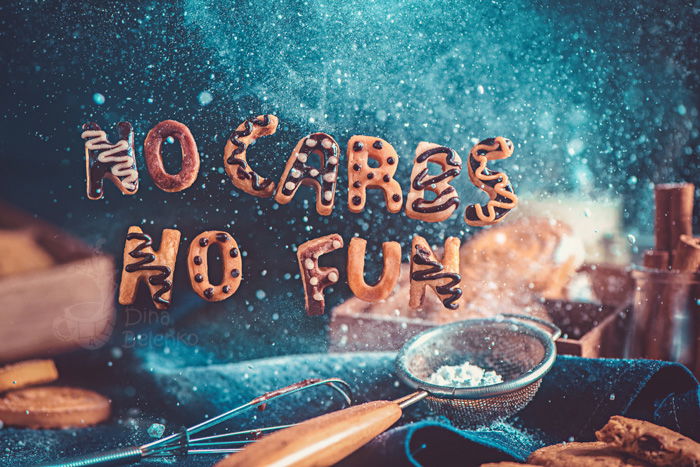
2. How to Form Food Typography Letters
I browsed through lots of food art photos for our article. I noticed that there are four major ways notable typographers and food stylists use to form their letters.
Sure, they all use very different tools and materials. Plus, many of these artists have unique and distinct styles. But I tried to simplify the techniques suitable for food typography and dimensional type in general.
I picked a few techniques a beginner can easily use. These suit someone who’s into creative food photography and still life but is unfamiliar with calligraphy or lettering. Ultimately, you have about four major choices:
- Finding food that looks like letters
- Forming words from a group of small food items
- Using kitchen forms and molds
- Using powder-like substances and templates
Let’s take a look at each of these ways one by one.
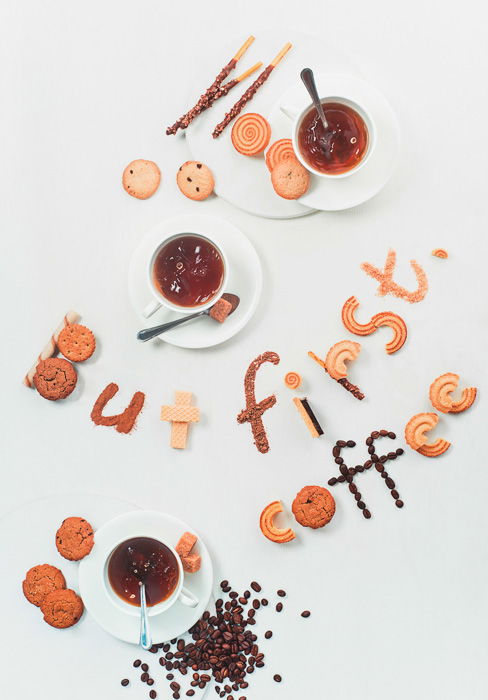
Food That Already Looks Like Letters
This is perfect for anyone looking for fun food ideas. For instance, the letter “O” can be created by anything round. It could be a donut or an egg yolk. You could use the imprint from a tea cup’s bottom on a linen napkin, a cookie, or a bowl of soup.
 My favorite approach is to pick a theme and search for food within its boundaries. The theme can be any food you like—sweets, vegetables, comfort food, desserts, pasta, salads, garnishes, spices, etc. You name it!
My favorite approach is to pick a theme and search for food within its boundaries. The theme can be any food you like—sweets, vegetables, comfort food, desserts, pasta, salads, garnishes, spices, etc. You name it!
Make a list of all the items related to this theme that you can use. You can then try to assign a letter to each one. For example, you can pick the theme of summer drinks:
- A slice of a big grapefruit can represent the letter “D”
- A slice of orange combined with a cinnamon stick can be “P”
- A spiral of peeled lemon zest can be “S”
- Four mint leaves can create an “X”
- A glass of lemonade with a cherry on its rim is a good stand-in for “Q”
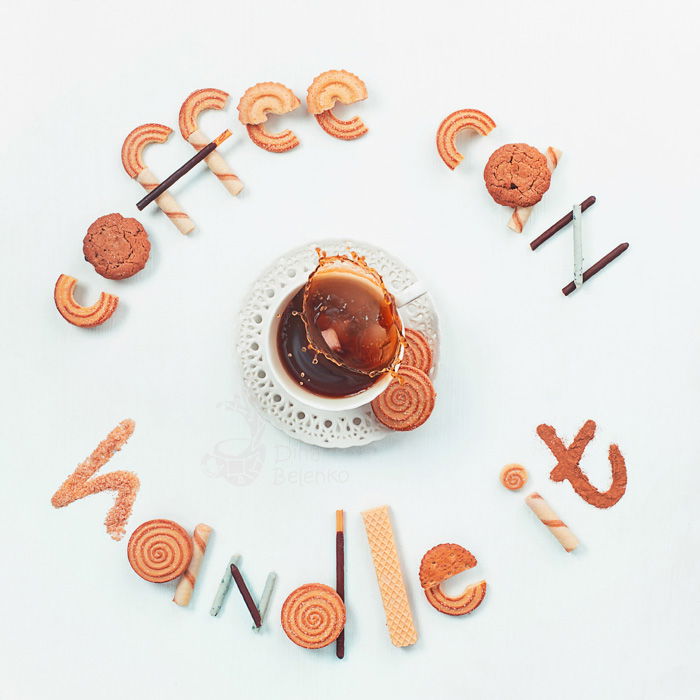
Use Small Groups of Food Items to Form Words
Take your time and be patient with the process. You can write words using small food items or outline letters to create a word. It can be rather simple and meditative.
Search your pantry and find something you’d like to work with. This could be peas, cherry tomatoes, basil leaves, black peppercorns, or colorful grains. Green mung beans and red (orange) lentils look great!
You can use berries of any kind, kumquats, or grapes. Bonbon truffles, marshmallows, or tiny cookies, work well. My first pick would be coffee beans. There are so many possibilities!
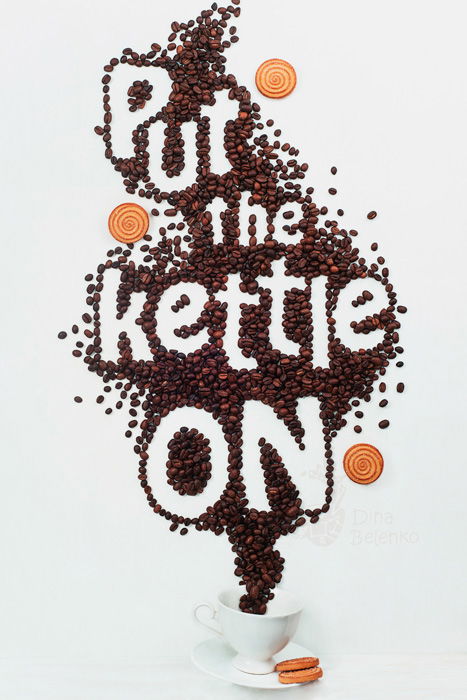
Lightly write words or mark the outlines of letters with a pencil. Then, use a pair of tweezers and put chocolate drops or your food of choice one by one on the letters or around the outlines. Be careful not to touch already-formed letters.
Ensure you have enough food to work through the entire word or sentence. Nothing is as frustrating as getting through half the sentence and discovering you’re out of hard candies or coffee beans!

Use Cookie Cutters and Kitchen Molds
First, you can use letter-shaped cookie cutters to bake an entire alphabet! Cookies are easy to work with since they can survive rough treatment. They’re not like delicate macarons or fragile cheesecakes.
You can play around with cookies endlessly until you create a perfect composition. You can even hang them in the air and try working with “flying” food! There are many possibilities here!

You can use cookie cutters to make decorative pie crusts in addition to cookies. Slice the sentence into the crust’s top before putting it on a pie. Add your usual decorative finishes, like ruffled edges, and bake it.
You can make the filling visible through your letters. Or you can dust it with powdered sugar to make it even more beautiful.
Small cookie cutters can also be used with marshmallows. Just dust them with flour so they don’t get sticky.
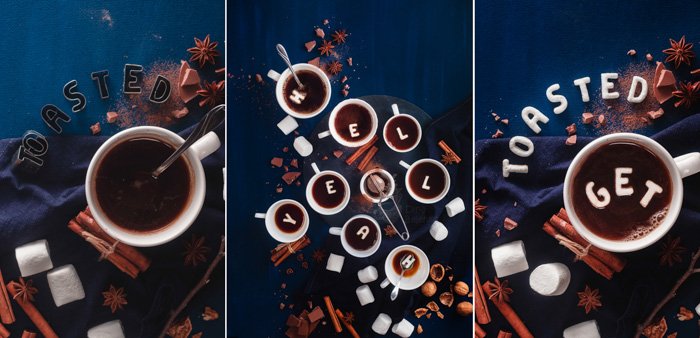
Other kitchen items you can use are a variety of alphabet ice cube molds or trays. Freeze some berries and mint leaves with your ice to create melting letters. The best thing about them is their volume.
This means you can use your alphabet of ice cubes for more than a flat lay. (Most food typography is flat-lay photography.)
For example, you could put “summer” into a glass of lemonade and add the word “sparkle” to a champagne flute. Use ice letters to write in a punch bowl or take a still life with soda.

And last but not least, silicon molds. This is the Holy Grail of food typography! Fill them with melted chocolate, let it cool down, and get your sweet chocolate letters!
You can melt some candies in them and get letters made from caramel. Or prepare some biscuit dough! Bake it in this mold, then decorate your cake letters with glaze or ganache. The best thing about this is that you can eat the props later!
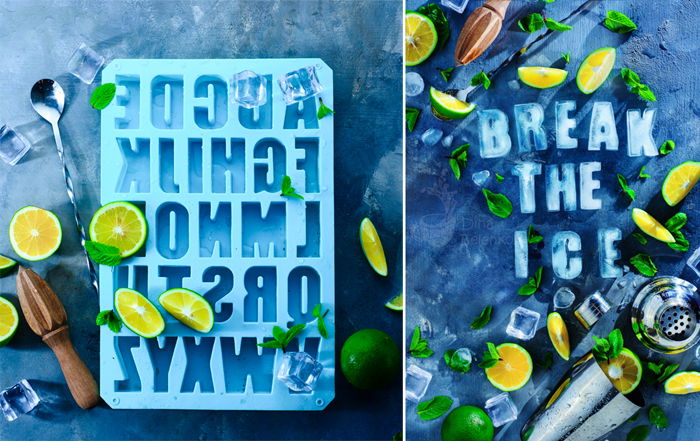
Use Powders and Letter Templates
Another way to play with words is to use a letter template. This is perfect for someone who doesn’t want to draw the letters and would rather work with an existing typeface.

This works in the following way. Print out the text you want to use onto a sheet of paper and cut it out with an X-Acto knife. Fill out the template with something free-flowing, like sugar, sprinkles, or baking confetti.
Carefully remove the template with tweezers and photograph the letters. Sounds pretty easy. Right? It is!

The main thing you need to keep in mind is using an appropriate font. Choose something with bold, easily recognizable letters. This is especially true if you want to scatter powdered sugar or sprinkles inside them.
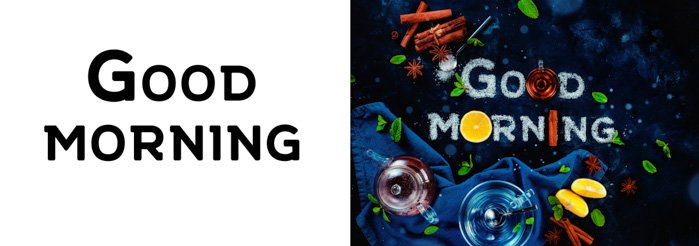
If you want to form letters with negative space, use italic fonts. Fonts like these try to imitate handwriting, so the letters are often connected.
Templates with aligned letters are easier to arrange evenly. And they’re easier to lift with tweezers when the backdrop is covered with powder.
If you form letters using negative space, the inner contour of the letters should be empty. And the parts of the background not covered with powder should form the word. The type below has aligned letters for working with glaze and sauces. (Also, good for an outer contour.)

Templates also work if you want to make your words from a liquid like syrup or jam. Attach your template to a background with double-sided tape. This is important because moisture can cause the template to curl otherwise.
Fill a small syringe or smear a hard brush with sauce, syrup, jam, or ketchup. The edges of the template will hold the liquid, preventing it from spilling. Surface tension is a fantastic thing!
Pictured below is how I made my first jam typography. Good thing white paper matched the color of my plate.!
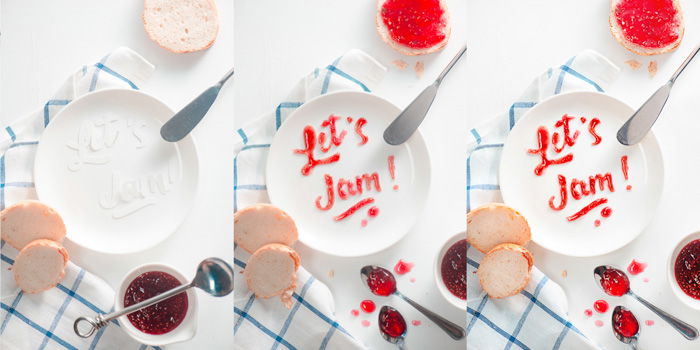
3. How to Pick Raw Materials for Food Typography
Molds, templates, and cutters are like traditional artist’s tools. Food items like grains, cocoa, and berries are like watercolors and paint. So, choose them with thought and care.
The connection between the font and the ingredient is important because it helps you tell your story. It makes sense to write about a healthy lifestyle with beans and peas.
Or you want to create words about happiness and hedonism with cookies and chocolate. Say that you love someone with words on a pie crust. Use melting ice cubes to talk about something time-sensitive or fleeting.
Use hot spices for something energetic and maybe a bit aggressive. And, sure, you can use baking glaze and sprinkles to warn people of the dangers of excessive sugar. Every detail adds something to the atmosphere. It makes your story richer and your image more interesting.
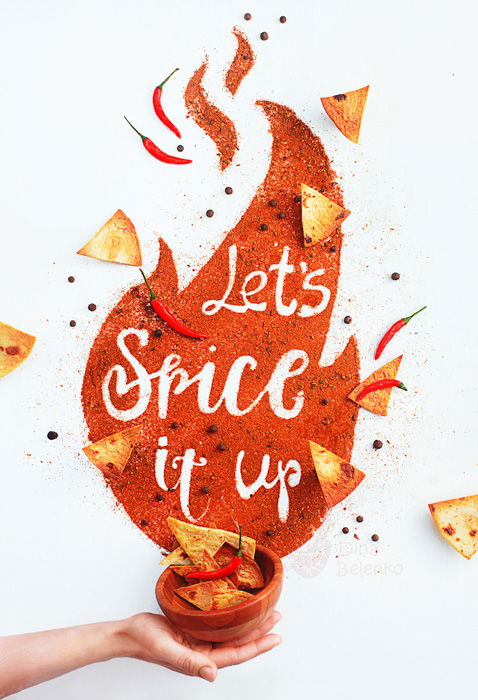
Step-By-Step Food Typography Tutorial
For this food typography tutorial, we’ll use a template. This is the simplest and most accessible way to get started in food art. It suits practically everyone. Even people with terrible handwriting (like me) can try this one and get a lovely shot!
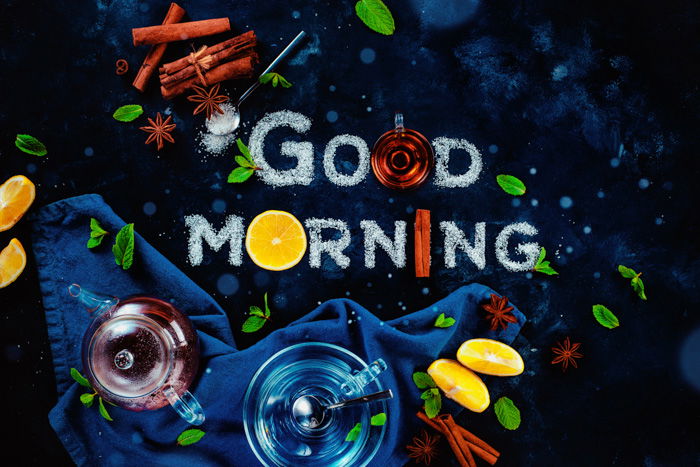
Step 1: Create a Template, Gather Props and Gear
The main thing we need is a paper template with letters. You can type a phrase you want to use with any font without thin serifs. Something like Gabriola looks perfect. You get bonus points for a message that makes sense in the context of your food or scene.
Phrases about productivity work well with a cup of coffee. And phrases about the little joys of life work with a cupcake.
Print your text and cut it out with an X-Acto knife or a small pair of scissors. Be patient. It may take some time, but the final picture is worth it.
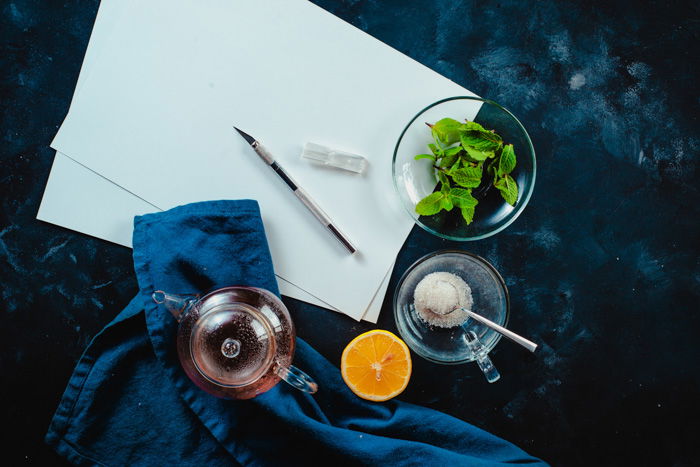 Larger letters are much easier to cut out. But don’t forget to check if your backdrop is large enough to include the entire message. For example, my backdrop was about 24 x 35 inches (60 x 90 cm).
Larger letters are much easier to cut out. But don’t forget to check if your backdrop is large enough to include the entire message. For example, my backdrop was about 24 x 35 inches (60 x 90 cm).
I wanted to include my text and still-life items like spoons and teacups in the frame. So, my letters were to be no bigger than 2.8 to 4 inches (7 to 10 cm).
Besides the template, you need the following:
- A pair of tweezers
- Additional objects for your still life, like lemon slices and napkins, to create the atmosphere
- A fine-mesh strainer
- Some sugar (or anything powdery like cocoa, cinnamon, paprika, turmeric, you name it)
- Some cotton swabs
You can use the tweezers you’re most comfortable with. Dental tweezers with curved ends are always the best choice, but regular ones will also work.
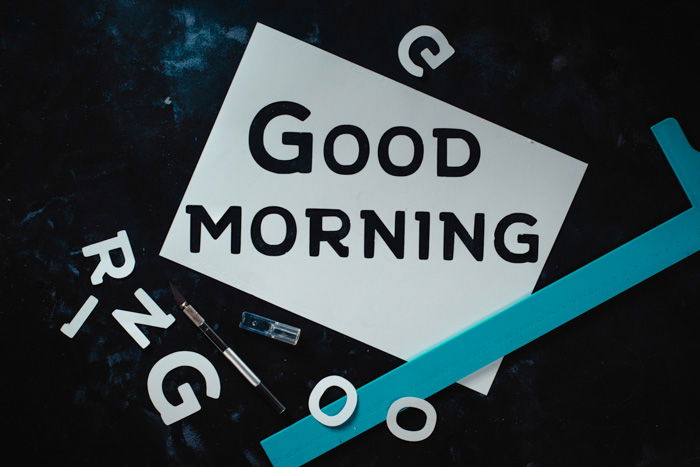
Step 2: Arrange the Composition
Usually, I prefer to work on the composition before filling in the template. That way, moving objects around is convenient without the fear of disturbing the text.
Place your template in the center of the composition (see image below). Then, arrange the other objects, starting with the biggest ones (napkins and cups). Then, move to the little details (mint and lemon slices).
This composition is rather simple. So, I arranged only my main objects, leaving the details for later.
It’s good to arrange your composition so that some objects interact with the words. That, hopefully, makes your viewers think about the time and effort you put into this photo. It should make them look at your work a little bit longer.
I decided to add some objects at the top of my sugar letters. I thought a small coffee cup covering the letter “O” would look nice.

Step 3: Form the Letters
Is everything in place? Perfect! Remove everything except the letters. Use a fine-mesh strainer to dust the template with sugar. That helps form an even, thin layer.
Make sure that the outlines of every letter are separated from the backdrop. That way, the message is easy to read.
You can also use a hard brush to sweep any sugar from the template inside the letters. This way, you can lift the paper without scattering excessive sugar on the background, distorting your text.
Remove the paper template with tweezers. Fix the shape of the letters with cotton swabs if needed.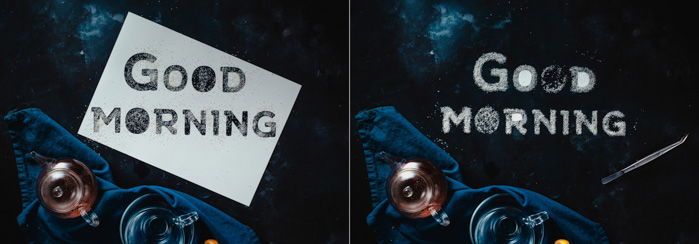
Step 4: Set Up the Lighting
Put all the food photography props back in their place and set up the lighting. You can use pretty much any lighting scheme you like. In my case, I used two speedlights. But I don’t see any reason not to shoot with natural light from a window if you want to.
I wanted the sugar to have a pronounced texture, so I used harsh key lighting. From the right, the scene was lit by a speedlight in a strip box. I placed this speedlight very low, on the same level as my backdrop—practically on the floor.
I used another speedlight behind a large diffuser on the left to balance that light and lift the shadows. The last touch was a reflector at the bottom.
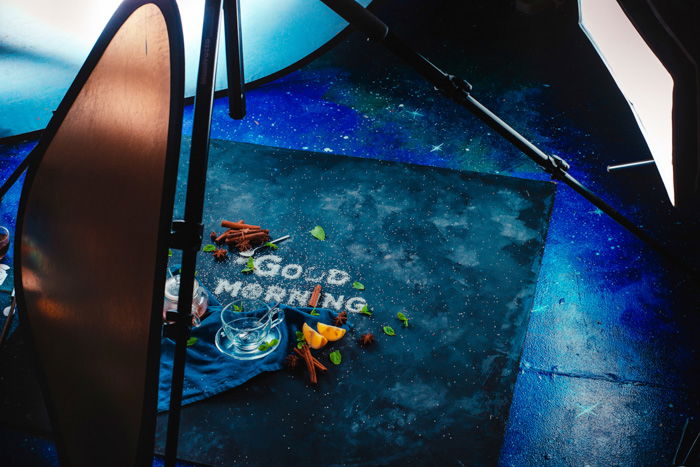
Step 5: Shooting and Post-Processing
Make sure you like your light and composition. Then, take a picture! To add some action, you may want to scatter some sugar from above or drop a sugar cube into a coffee cup. (Check out my tutorial about high-speed water-splash photography.)
There was almost no post-processing involved. I just made a quick adjustment of colors and contrast. In addition, you can delete any sugar particles that were too risky to remove with cotton swabs.
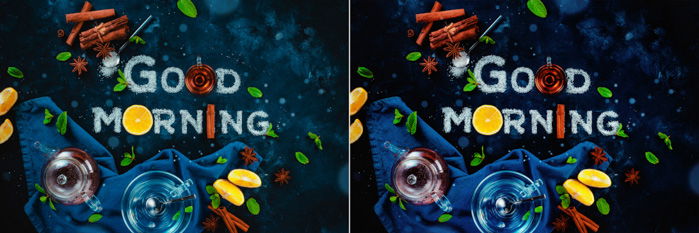
Voila! Your food typography kitchen poster is ready!

Food typography lets you add something new and creative to a food photography session. For example, you can try this tutorial with the template, replacing the sugar with paprika or cocoa.
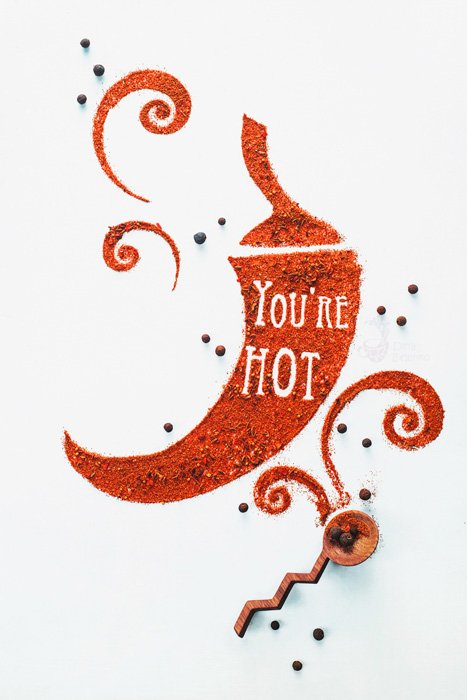
Write something tart with mustard and something sweet with a chocolate sauce. Note that scattered flour on a black background looks like the starry sky. So why not experiment with adding some silhouettes of stars and spaceships?
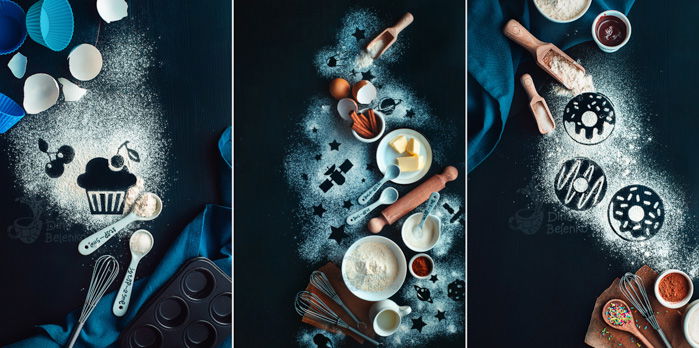
Conclusion: Food Typography
Try different materials with food typography and different ways of creating words. Find something that works for you to create original and special work! And most importantly—don’t worry about the mess and have fun!
